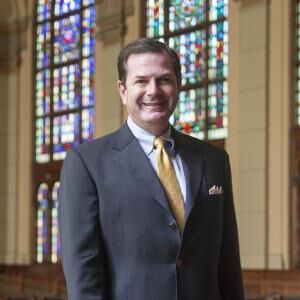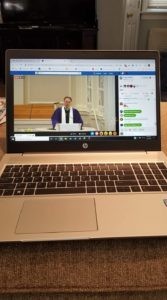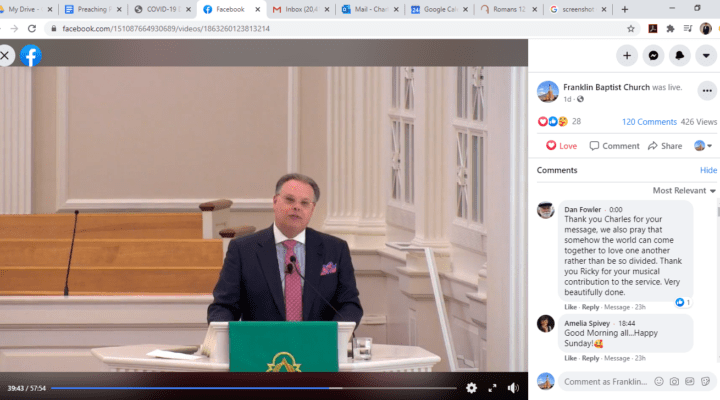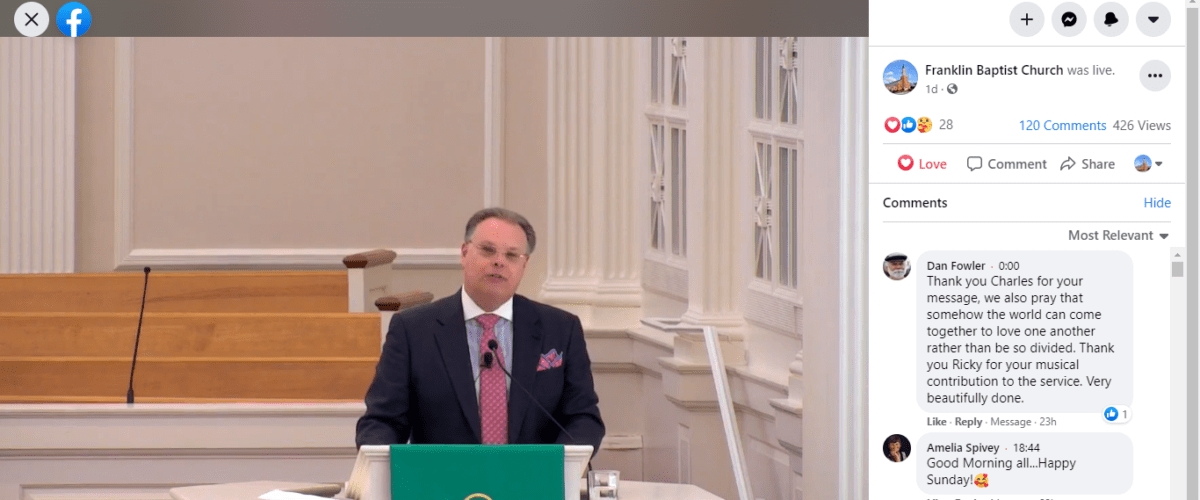The coronavirus is challenging the creativity of preachers as the pandemic continues to keep many churches in virtual spaces.
Months of speaking into camera lenses, laptop screens or empty sanctuaries week after week leaves some clergy feeling deprived of a vital connection with worshipers. Some also are overwhelmed at having to become techno-gurus in an age of prerecorded and livestreaming services.

Senior Pastor Elizabeth Mangham Lott appears in her first YouTube episode of “God Squad” in April.
“I miss the exchange of energy that happens in person when preaching,” said Elizabeth Mangham Lott, senior pastor at St. Charles Avenue Baptist Church in New Orleans.
Lott said she yearns to be able to tell when her words land — or don’t — when addressing a congregation. Online fellowship time helps, but it doesn’t quite measure up. “I miss the hard-to-quantify dimension of preaching in front of people.”
Nearly six months and counting since COVID-19 arrived with a vengeance in the U.S., clergy are beginning to accept that the longed-for reopening of sanctuaries is further off than originally assumed. In response, pastors are seeking ways to keep themselves, their flocks and their preaching fresh.

Pastor Rhonda Blevins preaches to her congregation on YouTube in May.
In some cases that means collaborating with other ministers on how to remain relevant from real or imagined pulpits, said Rhonda Blevins, pastor of Chapel by the Sea in Clearwater, Fla., and an associate with Pinnacle Leadership Associates. “We need to come alongside each other, as fellow travelers, and work together to sharpen our craft in these difficult times.”
Blevins is heading Pinnacle’s new “Transforming Preaching” initiative, which groups up to four ministers with a coach to hone homiletical skills in the midst of a volatile, changing and uncertain season.
Blevins, a former coordinator of the Cooperative Baptist Fellowship of Kentucky, said she, too, had to make significant adjustments to her preaching in the months before her church reopened to limited in-person worship. These included using a selfie-stick for mobile preaching, installing Zoom background images to keep viewers’ attention and reducing sermon lengths.
She also had to give up one of her favorite preaching devices: humor. “It was getting no reaction.”

Pastor Steve Wells has continued to preach sermons series throughout the pandemic at South Main Baptist Church in Houston. (Image/SMBC)
Pressure to make sermons count is increasing in some contexts where Sunday morning worship has become the only teaching moment. “Potluck suppers and mission engagement projects and Bible studies haven’t moved to online platforms in all churches,” she said.
The pandemic has ministers seeking inspiration, Blevins added. “A lot of the preachers I’m talking to want to be relevant, but we are also tired of talking about the pandemic. So, it’s about finding a connecting point on how we bring hope.”
Experiences have varied across pulpits.
For Steve Wells, senior pastor at South Main Baptist Church in Houston, remaining on course with sermon series has been an important response to the chaos of the pandemic. Another has been to use technology to heighten viewers’ sense of intimacy with their pastor.
“I preach live online. Which means I preach to three red lights — one about 30 feet to my right, one about 45 feet to my left, and one about 80 feet in front of me,” Wells said. “Because we have good camera lenses … I fill the screen and seem up close.”

Steve Wells
Wells preached a 10-week series on pandemic-related challenges such as isolation, parenting ever-present children and marital stress. Currently his topic is the Sermon on the Mount, a series he hopes might counter the nation’s toxic political situation.
The sermon has retained the centrality it had in worship at South Main before the pandemic, he said. “Virtual worship is better than nothing and still a far cry from being in person. Maybe that’s why Jesus came himself rather than sending a YouTube video.”

Charles Qualls preaching in an empty sanctuary at Franklin Baptist Church.
Being digital has changed the feel of preaching for Charles Qualls, senior pastor at Franklin Baptist Church in Franklin, Va. “Now that so many of our face-to-face meetings and events are not happening, the spoken word has taken on a premium,” he explained.
Qualls said he has leaned to the positive in lectionary-based series with themes such as good news in tough times and gratitude. Steps have been taken to improve the lighting and audio of services that have been shortened to 35 to 40 minutes. “My message is now more like 13-15 minutes,” he said.
Another change has been to rely less on manuscripts for preaching, a shift Qualls considers growth for him. “I am trying to connect with viewers through the camera.”
The ministry team at Franklin Baptist has become “little amateur producers of digital content” in the process, he said, noting one of the biggest losses is being able to crack jokes here and there.
“The season is a bit of a serious time, for one thing,” he said. “But humor without people in the room gives you none of the dialogue. If you try to say something that typically might be funny, the payoff you get right now is this awkward off-putting silence.”


